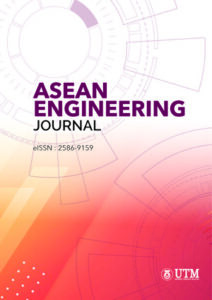SENSITIVITY ANALYSIS OF ANGLE, LENGTH AND BRIM HEIGHT OF THE DIFFUSER FOR THE SMALL DIFFUSER AUGMENTED WIND TURBIN
DOI:
https://doi.org/10.11113/aej.v11.18102Keywords:
Airfoil, Brim height, Diffuser augmented wind turbine, Power coefficientAbstract
This paper presents the performance of the diffuser augmented wind turbine (DAWT) with the various diffuser shapes using the numerical investigations. DAWT is also a type of wind turbine and the diffuser shapes, the nozzle shapes and the cylindrical shapes are commonly inserted around the horizontal axis wind turbine (HAWT) to become the more efficient wind turbine. The aim of this study is to find the more efficient design of the diffuser for the horizontal axis wind turbine using the numerical investigations. In this research, the converging and diverging diffuser shape is inserted and the airfoil design is calculated by using the Blade Elementary Momentum Theory. The airfoil type NACA 4412 is chosen because it is suitable for the low wind speed area and easy to produce. The turbulent model k-ω is combined with the Navier Stoke equation to solve the 3-dimensional steady flow simulation of the diffuser augmented wind turbine using the Computational Fluid Dynamics (CFD) simulations. The numerical investigation is used to compare and predict the power coefficient of the DAWT with various shapes. The baseline design of the diffuser (L = 170 mm, H = 57 mm and α = 11̊) is firstly investigated. To predict the power coefficient of the various diffuser shapes, the range of the length of the diffuser is (L/D = 0.5 to 1.5), the range of the brim height of the diffuser (H/D = 0.1 to 0.35) and the range of the angle of the diffuser (α = 5̊ to 15̊ ) are also investigated. The parameters of the diffuser shapes are assigned by using the Central Composite Design Face Centered Method. The response surface method is also used to predict the most efficient diffuser design. The performance of the horizontal axis wind turbine, that of the diffuser augmented wind turbine and that of the diffuser augmented wind turbine with various shapes of diffuser are compared. The performance of new diffuser augmented wind turbine (IND_009) is 50% and 55% higher than the baseline diffuser augmented wind turbine and the horizontal axis wind turbine at rated velocity. The flow visualization of the HAWT, DAWTs are also discussed.
















